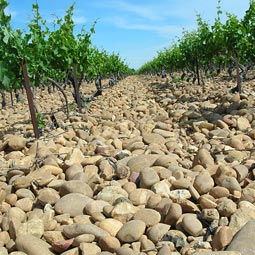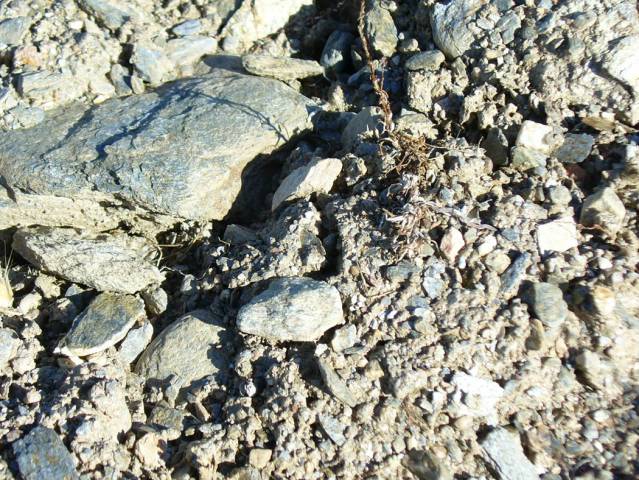During his MonteBello seminar Fri, Paul commented on the prevalence of limestone in the soils at MB.
It is well know that JoshJensen searched far & wide until he found a large outcroping of limestone on MtHarlan, which he apparently thought more important than climatic issues. Soil trumps climate in terroir??
The TablasCreek folks were primarily searching for limestone soils when they selected their parcel up in WestSidePaso.
The very chalky/limestone soils were the primary factor in JohnAlban’s selection of his vnyd.
There are wine people who claim they can taste the limestone/chalk from the soils in wines grown on those sites. Yet scientists scoff at the idea that there is a direct transfer/transport for those minerals directly into the juice of the grapes. Paul acknowledged that those studies are probably correct.
I’ve had some spectacular wines from granitic soils, clay soils, sandy soils, alluvial soils, slate soils over the yrs.
So…somebody that actually has some knowledge (sorry…that eliminates some 99% of those of us on these wine boards)…what is it that makes limestone soils so sacrosanct for growing grapes…that makes limestone soils so far superior over all other types of soils?? Or is it, in reality?
Realizing, of course, that if you’re a vnyd owner, that the type of soil that composes your vnyd is obviously the World’s most superior type of soil.
Tom (stirthefrigginpot.gif)
I believe it is the unique ability to drain better than almost all other types of soil.
I’m the 99% in this and many other respects.
One thing that limestone soils are good at is allowing the roots to extend far and wide. Also gives good drainage while not letting all of the water disappear as it percolates through the limestone creating new crevasses.
Limestone will also increase the PH of the water/soil so might might add to the factors.
I always get a kick out of pictures like this, just looks stressful, which ends up making great wine.

Exactly. pH is a factor. Drainage and water retention are factors. So too, the admirable history of it in France and elsewhere. I think they all play into it. Good point on climate vs. soil Tom. I think soil might win but not by much. Obviously climate is important. Plenty of tough places to grow grapes have loads of beautiful limestone.
Yes, the more experienced I get, the more I find that limestone does add particular elements to wine – but that doesn’t mean that there is a direct transfer/transport of minerals directly to the juice. Ditto, of course, for slate, porphyr, etc.
BTW, in an interview in La Revue du vin de France some years ago, Claude and Lydia Bourguignon asserted that 32% of the world’s surface limestone is located in France. Something that goes a long way to explaining both French wine and the look of French cities/historic architecture.
I don’t think all oeno-geological roads lead to limestone, Tom. Cote Rotie has schist and granite. The western side of Barolo (La Morra and Barolo) has clay-heavy soils (vs. more limestone in Monforte and Serralunga). There is chalk in the Medoc, but some areas are more clay and gravel, I believe.
John – chalk is a form of limestone; I suspect that its presence in the Médoc is one reason why Paul brought it up with respect to Monte Bello.
You quoted before I corrected.
Tom, an excellent discussion. My own opinion is that climate is paramount, and soil comes next in the hierarchy, but maybe that’s just stating the obvious? No one would claim that great wine could be made in perfect soil in Barstow or Halifax. Certainly (for me) no amount of great soil can rescue the overripe wines produced by Alban and Tablas. Maybe the soils do add something of interest, but the climate has still dictated the end result.
I definitely agree with your observation that great wines can come from a broad range of soil types.
Sort of like this?

Livingstone-Learmonth wrote in his Wines of the Northern Rhone, “Most growers would tell you that they prefer not to have limestone, which doesn’t bring out the true power of the Syrah”.
Rocks break down during weathering and minerals are freed to fertilize the plants. These “fertilizing minerals” might not make it to the fruit but they do get stored in the tissue of the plant effecting the health and overall wellbeing of the plant.
Different rocks also have different pH (as mentioned above). The Levet family in Cote Rotie apply lime to their Chavaroche parcel to rebalance the soil’s pH. Chavaroche is composed of an acidic schist which apparently becomes too harsh an environment during drought. Adding lime brings the natural pH of the schist back towards neutral.
Different strokes for different root stocks I guess. Hard to argue that Syrah from Cote Rotie is the pinnacle of expressions of the cepage. Same for Pinot from Burgundy.
Scientists might be right about minerals not finding their way to the fruit. Still, I am willing to wager the plants in Burgundy and Cote Rotie wouldn’t produce the same monumental wines if Pinot was planeted in Ampuis and Syrah in Beaune. A similar example with some real evidence is the Gamay that goes into Passetoutgrains, not exactly Cru Beaujolais is it?
Is this not because of climate, not soil?
Paging Kevin Harvey . . .
I think he can talk about this for several hours.
Best, Jim
Its all about Cation exchange baby.
Grapes can hang longer but still maintain a low PH/good acidity levels. This is still not completely proven nor understood I believe.
Great write up on Tablas Creek website.
Yes, and Rayas (and Roero) have sand and Etna has its volcanic pumice. Limestone by itself is not the sine qua non for grapegrowing, but I feel for Burgundian varieties of chardonnay and pinot noir, it does add a little something special to the mix. For other varieties, I feel the jury is mixed. In California, I think climate trumps the limestone, and in places like Paso Robles the limestone is mixed in the soil, not pure limestone morphology underneath.
Au contraire, Alan.I guess I’d dispute that assertion on Tablas being overripe. Certainly not compared to Alban. Certainly not compared to the big WestSidePaso
names like LinneCalado/Booker/Epoch/Saxum and such. I find the Tablas wines are some of the more restrained and balanced, especially for WestSidePaso,
wines made in Calif. Compared to Peay, TreViti, Boheme, Failla?? Then you have a point. As for Alban…that’s a pretty darned cool growing area (ask BobLindquist
across the road from John)…but the wines merely reflect John’s choice in style.
Tom
I would love to, but no one would listen!!
Seriously though, here is a quick summary of some of our observations. We have 7 vineyards each with a distinct soil/geology profile. Within (and across) those vineyards we have about 30 weather stations. Given the undulating terrain in California Mtns, there can be almost as much intra-vineyard climate variation as there is across vineyards. Looking at this data, we have found that Pinot can be very successful across a very wide range of climatic conditions (just as Burgundy illustrates year to year with a very variable climate). We have also found that the conventional wisdom that “wine is different in the Mtns due to climate” is not true. The climate in the Mtns is often not meaningfully different than lower elevations. Instead the soil profile (ie much rockier and more shallow) is the more meaningful difference. Using Winkler’s (simple but useful) measurement system, Pinot can be successful in climates that vary from 1800 Heating Degree Days (HDDs) to 2600 HDDs. This is a very wide range. Within that range, we have found that soil is the primary determinant of wine quality. So to summarize, soil is the most important factor as long as you are in the climatic ballpark.
There are a few things that are unique to limestone. First there is the somewhat obvious Calcium which is a vital vine nutrient (and also affects the uptake of other nutrients). Limestone also weathers into fine particles that create clay soils. This is why clay soils are often found over limestone subsoils. These clay soils have a high CEC (cation exchange capacity) or ability to transfer nutrients to the vine. Shales or schists and slates also weather to fine particles that create clay soils. CEC is lower in sandy or silty soils. In Burgundy’s Grand Crus, the combination of high CEC clay and rocky, shallow soils provides a perfect “gas pedal and brake”. The clay provides lots of vital nutrients, the rocky soils provides drainage (water availability is a key component of terroir expression) and the shallow soils limits vigor and promotes ripening and concentration. Limestone plays a key role but shales can emulate most of these physical properties.
I’m listening.
Best, Jim